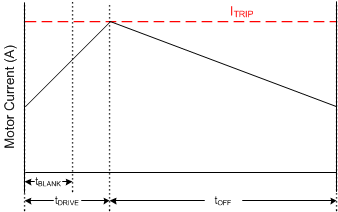SLVSFZ7 November 2021 DRV8231
PRODUCTION DATA
- 1 Features
- 2 Applications
- 3 Description
- 4 Revision History
- 5 Device Comparison
- 6 Pin Configuration and Functions
- 7 Specifications
- 8 Detailed Description
- 9 Application and Implementation
- 10Power Supply Recommendations
- 11Layout
- 12Device and Documentation Support
- 13Mechanical, Packaging, and Orderable Information
Package Options
Mechanical Data (Package|Pins)
Thermal pad, mechanical data (Package|Pins)
Orderable Information
8.4.2 Current Regulation
The DRV8231 device limits the output current based on the analog input, VREF, and the resistance of an external sense resistor on the ISEN pin, RSENSE, according to Equation 1:
By using current regulation, the device input pins can be set for 100% duty cycle, while the device switches the outputs to keep the motor current at the ITRIP level. For example, if VREF = 3.3 V and a RSENSE = 0.15 Ω, the DRV8231 limits motor current to 2.2 A during high torque conditions. For guidelines on selecting a sense resistor, see the Section 9.2.1.2.3 section.
When ITRIP is reached, the device enforces slow current decay by enabling both low-side FETs, and it does this for a time of tOFF.
 Figure 8-3 Current-Regulation Time Periods
Figure 8-3 Current-Regulation Time PeriodsAfter tOFF elapses, the output is re-enabled according to the two inputs, INx. The drive time (tDRIVE) until reaching another ITRIP event heavily depends on the VM voltage, the back-EMF of the motor, and the inductance of the motor.
If current regulation is not required, the ISEN pin should be directly connected to the PCB ground plane. The VREF voltage must still be 0.3 V to 5 V, and larger voltages provide greater noise margin. This provides the highest-possible peak current which is up to IOCP,min for a few hundred milliseconds (depending on PCB characteristics and the ambient temperature). If current exceeds IOCP,min, the device may enter the fault mode due to overcurrent protection (OCP) or overtemperature shutdown (TSD).